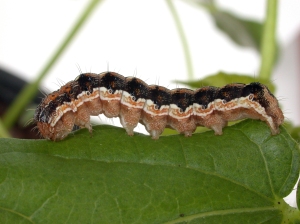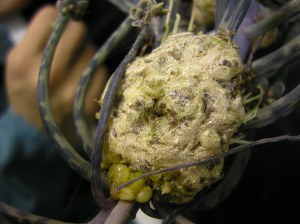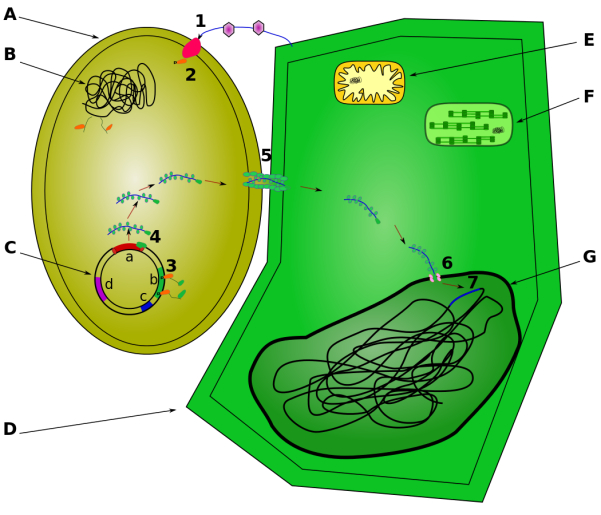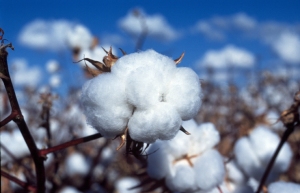Genetic modification (GM, genetic engineering) for eukaryotes matters because we humans are eukaryotes and we use eukaryotes. As you know, eukaryotes have nucleated cells.
Among the eukaryotes we eat angiosperms (flowering, fruiting plants), herbivores which eat them, and predators which eat herbivores. We use angiosperms for textiles and buildings. We fight eukaryote pests, some of which attack angiosperms.
The most efficient, therefore the most widely-used method for making GM angiosperms uses modified strains of Agrobacterium tumefaciens. Since bacteria, including this one, are prokaryotes (having no cell nucleus) the Agrobacterium method involves prokaryote GM.
Agrobacterial GM has been used for dicots such as cotton (Gossypium hirsutum) and soya (Glycine max). Dicots are dicotyledenous angiosperms, whose seeds’ starchy endosperm is in two halves.
Agrobacterial GM has been used also for monocots such as rice (Oryza sativa) and maize (corn, Zea mays). Monocots are monocotyledonous angiosperms, whose seeds’ endosperm is single.
As an example of agrobacterial GM, here I describe cotton which has been modified to protect itself from the Old World bollworm (Helicoverpa armigera) by making an insecticide in its tissues.
For now I’ll stop short of discussing controversies around GM. For now.
Pests attacking crops
Some invertebrate pests attack crops. For example, moth larvae called bollworms are pests on cotton (Figure 1).
Bollworms attack leaves and stems but their name derives from their invasion of cotton bolls. Bolls are cotton fruits which open into burs when ready to harvest.

Figure 1. Lepidopteran pest on a dicot.
Photograph shows an Old World bollworm caterpillar on a cotton leaf.
Source: David McClenaghan via the Commonwealth Scientific and Industrial Research Organization (CSIRO). https://commons.wikimedia.org/wiki/File:CSIRO_ScienceImage_7410_A_larva_of_Helicoverpa_armigera_the_worlds_worst_insect_pest.jpg
A bacterium inserting DNA
GM by the Agrobacterium method exploits a pathogenic bacterium, A. tumefaciens. Wild-type Agrobacterium is a pathogen of dicots, causing uncontrolled growth called a crown gall (Figure 2).
Figure 2. Crown gall caused by wild-type Agrobacterium infection of a dicot.
Photograph shows a kalanchoë (Kalanchoe blossfeldiana) twig after infection by Agrobacterium. A rounded gall is visible.
Source: Photograph by Bhai, used under a Creative Commons licence. https://en.wikipedia.org/wiki/File:Crown-gall_detail.jpg
Crown galls, and agrobacterial GM, can occur because Agrobacterium transforms plant cells. That is, this bacterium inserts DNA.
Transfection occurs when T-DNA (transfer DNA) invades the host cell’s nucleus and becomes incorporated into the host genome. T-DNA is carried by the agrobacterial Ti (tumour-inducing) plasmid: a small circular DNA molecule performing transfection.
Ti is not required for agrobacterial survival but it is required for the bacterium’s use in GM. Ti carries vir (virulence) genes which are required for transfection, but which are not transferred to the host cell.
Agrobacterial GM
For agrobacterial GM, Ti is transformed. Genetic engineers replace genes on the plasmid, encoding amino acids called opines which lead to gall formation, by genes of their choice.
Engineers isolate (purify) desirable DNA and use it to make a transgenic construct. In such a construct, the chosen gene is accompanied by promotors (sequences which drive gene expression) and by marker genes which will allow transfected cell lines to be identified.
Ti remains within Agrobacterium while the plasmid is transformed by inserting the transgenic construct. The most efficient method for this transformation of Ti is electroporation, in which bacterial cells in a liquid medium receive an electric shock.
Transformed Agrobacterium is mixed with plant cells to allow transfection (Figure 3). This step is performed in a liquid medium.
Figure 3. Agrobacterial transfection.
Diagram shows an A. tumefaciens cell (A) containing that bacterium’s chromosome (B) and Ti plasmid (C). On the plasmid T-DNA (a), vir (b), the origin of plasmid replication (c) and the gene for opine catabolism (d) are indicated. Locations of T-DNA are shown in sequence 1-6. Diagram also shows a plant cell (D) containing a mitochondrion (E), chloroplast (F) and nucleus (G). One mitochondrion and one choroplast each represents several of those organelles which are found in a plant cell.
Source: Chandres via Wikimedia Commons. https://commons.wikimedia.org/wiki/File:Transfection_by_Agrobacterium.svg?uselang=en-gb
After transfection, cells are spread onto solid selective agar containing the antibiotic to which the marker gene confers resistance. Therefore, cells in which transfection was successful are the only cells which grow into colonies.
Cell colonies are picked off the agar and grown into plants. These transgenic plants are tested for transgene expression in the lab, in the greenhouse and in the field.
Example of agrobacterial GM: Bt cotton
Some agrobacterial GM exploits the soil bacterium Bacillus thuringeiensis (Bt) which makes insecticides in its cells. GM exploiting Bt builds on the use of Bt since the early 20th century as a crop treatment.
Insecticides from Bt are the Cry (crystal toxin) proteins encoded by cry genes. Cry proteins are toxic to specific invertebrates, many of which are pests.
When agrobacterial GM has been used to insert cry into crop plants, these plants make Cry in their tissues. Therefore they are insecticidal: the Bt crops.
For example, cotton resistant to bollworms (Figure 1) has been made by inserting cry genes into the cotton genome. Such Bt cotton has become important in agriculture (Figure 4).
Figure 4. Bt cotton ready to harvest.
Photograph shows healthy cotton burs in a field near Narrabri, New South Wales.
Source: Jane Kahler via CSIRO.
http://www.scienceimage.csiro.au/tag/cotton/i/3251/cotton-boll/
Making the most of Agrobacterium
Some GM crops made by the Agrobacterium method carry multiple inserted genes. These ‘stacked’ genes may include multiple cry genes, providing complementary attacks on the pest, and other useful genes.
Not everybody is impressed by Agrobacterium or by GM in general. As promised at the start of this article, I’ll discuss the controversies in due course.



